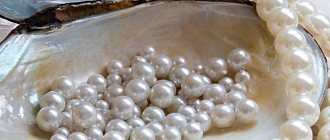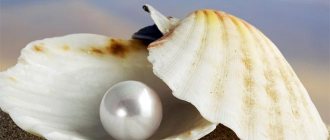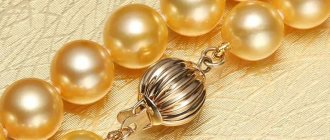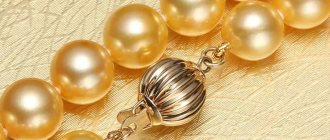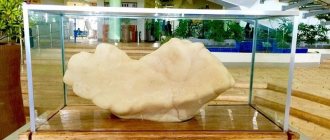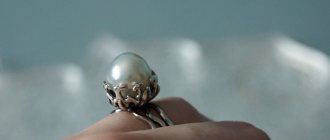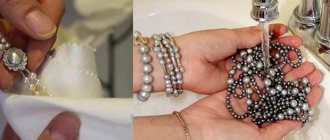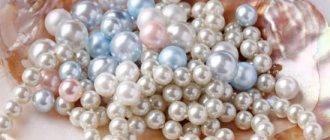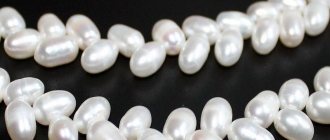Story
People have known what pearls are since ancient times. It has long been found in the shells of marine and freshwater mollusks. This stone is the most ancient jewel on our planet.
It is believed that it was first discovered by accident while catching edible bivalves. Scientists believe that this happened in the waters of the Gulf of Mannar about 4,000 years ago .
The gem began to be used as jewelry and even as a monetary equivalent.
He was highly valued in the East - from China to North Africa, and was adored by the queens of ancient times - Semiramis, Cleopatra and others. The importance of pearls was so great at that time that Cleopatra considered earrings with two large pearls the most valuable of her jewelry.
This stone was highly valued in countries with access to the sea. They decorated statues of gods and heroes and were awarded for military exploits.
On the famous Monomakh's hat, pearls shimmer softly among other gems, and it is crowned with a cross with pearls.
Since the Middle Ages, these stones have been used to decorate crosses, icons, and robes of clergy, since among Christians pearls are a symbol of infallibility and purity.
The Russian word “pearl” comes from the Chinese name for this stone - “zhen zhu”. In Rus' it appeared through the Volga-Bulgar and ancient Turkic languages.
In most European languages, the name of this gem has the Latin root perl. It comes from a now unused word that denoted a specific type of mollusk.
In Russian, nacre is the outer coating of pearls.
Interesting facts about pearls
Although pearls are recognized as a precious stone, they are not extracted from the bowels of the earth. It is the rarest among precious minerals. The popularity of jewelry with it is growing every year. Because of this, barbaric harvesting methods have led to the destruction of many shellfish populations.
The first spherical artificial pearl was grown by the Japanese. Before this, no one had been able to obtain an analogue of natural origin. Although there have been numerous attempts around the world to extract the mineral using artificial methods, only Kokichi Mikimoto managed to create the perfect cultured pearl. This happened in 1888, when a farmer began to scrupulously test options for growing gemstones, creating the first shellfish plantation on the planet. Only after two decades, filled with numerous trials causing various errors, the Japanese managed to patent round artificial pearls.
Only one in ten pearls sold are of natural origin. Although the production of the cultivated product is continuously growing, the population of mollusks in nature has not yet been fully restored. Even on farms where ideal conditions have been created for them, not every shell produces a pearl. This process is long and extremely complex. Even with a successful outcome, not every stone is capable of decorating a piece of jewelry.
The most expensive fake pearl necklace is the one worn by the first American lady, wife of President Kennedy. The fake jewelry belonging to her was sold through an auction, receiving $211,000 for it. Celebrity biographers claim that Jacqueline purchased this trinket in a department store back in the fifties. It only cost her $35.
Origin
Pearl is a stone of organic origin. Scientists do not consider it a mineral, but according to a long tradition it is classified as a precious stone.
Pearls are formed in the organisms of freshwater and marine mollusks. Sometimes grains of sand, shell fragments and other foreign objects get into sinks. If they come into contact with the mollusk's mantle (the soft shell that hides under the shell), the mollusk covers them with a layer of material that makes up its shell. This is how pearls are formed.
Sometimes several dozen pearls of various shapes are formed in the shell. But the greater their number, the smaller they are.
Only pearls that have a mother-of-pearl shell are valuable.
Pearls are found inside only some bivalves and gastropods, as well as the cephalopod nautilus. But zoologists believe that all types of mollusks can produce them.
How to distinguish real from fake
Since pearls are a rare stone, they are actively imitated. There are different types of fakes, but it’s not difficult to check them even on your own. Evaluate the color, appearance, weight and surface cleanliness of the pearl product:
- Natural stone is heavier than artificial stone. Inside the natural mineral there is mother of pearl, while in a fake product the core is made of plastic or other light artificial material.
- A real mineral has a uniform shine. It is easy to identify a fake by the presence of dullness or uneven shine.
Additional verification methods:
- If you have individual pearls in your hands, do a simple test - you need to drop a pebble from a height of half a meter. When struck, a real mineral bounces back like a ball. The artificial stone will roll across the floor.
- Rub the pearls against each other with little force. There will be scratches and small particles of powder on your fingers. They are easy to remove; just wipe the surface of the pearl with your palm.
- Place the suspect material in acetone. The fake will begin to dissolve in it.
- To ensure the authenticity of the purchased stone, it is better to visit a jeweler who will accurately determine the authenticity.
Physicochemical characteristics
From the point of view of chemists, pearls are a composite of an inorganic substance (calcium carbonate) and an organic substance (conchiolin, a horny substance produced by the mollusk).
- The chemical formula is CaCO3 .
- Color - white, silver, yellowish, golden, blue, cream, green, pink, gray, black.
- The shine is pearlescent.
- Transparency ranges from translucent to opaque.
- Hardness - 3–4.
- Density - 2.6–2.78 g / cm3 .
The structure of the stone is layered.
Soluble even in weak acids.
History of origin and properties
Pearl is a stone, the only precious mineral of animal origin. A grain of sand that falls into a sink remains there forever or until people find it. It lives by growing layers of mother-of-pearl and turning into a pearl pea.
As a species, it has existed as long as the seas and oceans on Earth. All nations have legends and traditions about the beautiful pearl.
The shape of pearls depends on their origin. For a sea fish it is correct, but for a river fish there is no such perfection, and large sea fish may lose their spherical shape, but they do not lose value.
The degree of transparency of pearl stones ranges from translucent to densely opaque.
Mining locations
Pearls are obtained from the shells of marine and freshwater mollusks, more often bivalves (mussels, etc.).
Sea “wild” pearls are found in:
- Persian Gulf;
- Gulf of Mannar;
- Red Sea.
For warm countries washed by the ocean or sea, the profession of pearl diver was traditional. But it is associated with a risk to life, which is why shellfish plantations are now being cultivated in many countries.
There are pearl plantations:
- off the coast of Japan and in some lakes of this country;
- in Burma (in the Bay of Bengal and the Andaman Sea). Burmese pearl is one of the best in the world.
Cultured pearls are no different from wild ones. The core of the future pearl is simply placed into the shell by specialists. After this, under their supervision, the invertebrate grows (and grows the pearl) for several years.
The largest jewel found in a mollusk shell is the “Pearl of Allah.” Its weight is 6.5 kg , and the weight of the mollusk is 300 kg . This jewel has an oblong shape and impressive dimensions - 24 x 16 cm .
Pearl is also found in clean, large rivers of Europe, Asia, and North America. Freshwater pearls are mined in:
- Russia;
- Germany;
- China;
- USA.
Interesting fact. One day, a South Korean resident bought pearl shells for a traditional Korean dish for 60 cents In one of the shells he discovered a rare black pearl with a diameter of 1.5 cm . It was valued at $60,000 .
Cultured pearls
Farm for growing cultured sea pearls
The process of forming cultured pearls consists of creating artificial conditions, introducing an irritant that provokes the mollusk to secrete nacre, similar to what happens during the formation of natural pearls. There are several ways to obtain cultured pearls: freshwater or saltwater, with a transplant into the gonads of a mollusk or mantle, using a central nucleus or a nuclear-free method. The mortality rate of molluscans after transplantation is at the level of 10-40%.
For the first time on January 27, 1896 in Japan, Kokichi Mikimoto received a patent for semicircular pearls grown by nuclear technology. Industrial production of these pearls began in the 20th century. In this method, a mother-of-pearl ball made from the shell of a freshwater mollusk was used as the core. The pearlescent layer above the core is called the nakr.
Nowadays, saltwater cultured pearls are grown using the nuclear method.
Colors and varieties
The color of pearls varies: from white to light shades of pink, green, blue, and gold. There are gray, silver, rich green, black pearls.
The surface of the pearls only seems smooth. It is wavy, inhomogeneous, and light interferes with it. Therefore, on the pearl you can observe the play of color - from light yellow to pink and blue.
The color and shape of pearls depend on the type of shellfish, purity, salinity and temperature of the water.
Types of natural pearls:
- River - small (diameter - up to 7 mm ). White, yellowish, cream, grayish. Shape - from spherical to elliptical.
- “King” is large ( up to 22 mm ), with a thick layer of mother-of-pearl. Colors are different. Found in the southern seas.
- "Mabe" is very large. The shape is perfectly round. The color range is from silver to black.
Types of cultured pearls:
- "Tahiti" - medium size - up to 12 mm in diameter. Gray range - from silver to black.
- “Akoya” is larger (diameter up to 14 mm ). Coloring in all colors except blue.
- "Kasumi" - Japanese pearls. Exotic color - from golden to purple.
Among the natural and cultivated gems, the following varieties are found:
- “Baroque” (baroque pearls) - characterized by irregular shapes. Small, up to 5 mm . Different shades: gray, white, cream.
- “Paragons” are unique pearls that resemble the silhouettes of a person, animal, or plant.
In addition to natural and cultured pearls, there are also artificial pearls - artificially grown or synthesized mother-of-pearl stones. They are always perfectly spherical.
What are pearls
This is a solid biogenic formation that has a round or irregular shape. It forms inside the shells of certain mollusks. The mined pearls are beautiful in shape and have a unique mother-of-pearl shell that seems to shimmer.
Pearls are not as hard and durable as crystalline stones, although they are quite resistant to the chemical components of the air and products of human activity. The mineral has a unique palette; it is capable of producing a color tint effect. The most common are spherical varieties of pearls, although oval, pear-shaped or teardrop-shaped ones are also found. But the cost of the specimen increases sharply precisely with its spherical shape.
Important parameters of a natural nugget are gloss, color and surface interference. 120 varieties of this stone are classified according to the color palette alone. The most common is silvery white, although pink, yellow or cream shades are often found. Oyster catchers also come across blue, black or green pearls. The color is affected by the composition of the water, the depth of the mollusk, and temperature conditions.
Medicinal properties
Pearls have an interesting feature - they fade or change color and thereby signal health problems of their owner.
This change in the appearance of the stone occurs if the owner’s skin acidity increases. Thus, the diagnostic properties of the pebble indicate that an unfavorable process has begun in the body. In this case, it is better to consult a doctor to check the whole body.
The healing properties of pearls should be used in combination with treatment prescribed by the attending physician.
Lithotherapists believe that this gem helps with:
- stomach diseases associated with changes in acidity;
- problems with the liver, kidneys, and, to a lesser extent, with the intestines;
- eye diseases (helps reduce the amount of discharge due to conjunctivitis and other eye diseases).
The following healing powers are attributed to him:
- Regulates the nervous system.
- Improves memory.
- Supports immunity.
- Normalizes blood pressure.
Tibetans hold a pearl in their mouth to cleanse the blood - every day for 15 minutes .
It is believed that pearl water can cleanse the body: you need to put pearls in the water for 12 hours and drink it throughout the day . The healing properties of such water are effective only for one day .
Imitation pearls and how to recognize a fake
In the beginning, imitation pearls were made from glass. In the XV-XVI centuries, “Roman pearls” were created. It was a glass ball filled with paraffin.
Faux pearl necklace
Also, based on fish scales, they made “pearl essence” (the chemical substance guanine), which imparted a pearlescent shine. The glass beads are coated with “pearl essence”, then sintered in a kiln, and then the process is repeated 3-4 times.
In the 20s In the 20th century, imitation “shell pearl” appeared in the USA - mother-of-pearl cores coated with varnish.
Imitation pearls can be distinguished by several characteristics. Firstly, if it is plastic, it will be too light compared to pearls. If it is glass, then the surface is very smooth, matte whitish glass is visible inside the hole, and under a 10x magnifying glass specks of dye are visible.
Manufacturers often try to refine low-quality pearls to increase their sales. To do this, it is common to use tinting and irradiation. They paint, for example, with lapis (silver nitrate), which causes the pearls to turn brown over time. Although there are currently many different dyes, both natural and artificial.
Distinctive features when tinting include spotty coloring (visible under a magnifying glass). Due to the fact that the porosity of different parts of the pearl is different, the coloring does not apply evenly. And around the hole of the tinted pearl the color is more intense.
Irradiation can be done with X-rays, as well as neutrons, etc. When irradiated, the pearl becomes black throughout the entire volume of the pearl, this is typical for freshwater pearls, which do not have a core. Irradiated pearls also take on an unnatural metallic tint. In sea pearls, only the core reacts to irradiation, so the color of the pearl partially changes from the inside, as if the core is dark inside.
Magic properties
Among different nations, pearls are a symbol of purity, purity of soul and thoughts.
He favors only sincere people with a pure soul and does not help those who are deceitful and treacherous.
The meaning of pearls for a person is many-sided: this stone symbolizes longevity, fertility, material independence, and the strength of marriage bonds.
Talismans and amulets
The magical properties of pearls were valued by ancient Roman emperors. They believed that talismans made from it strengthen power and make a person wiser.
Now it is believed that pearl talismans are more suitable for women, enhancing the gentleness of their character and maternal wisdom.
In Asian countries, pearl jewelry is traditionally used as amulets. They believe that if bad thoughts and intentions of other people are directed at the owner, the stone will darken and lose its color.
Other properties of pearl amulets:
- They relieve you from the torment of unrequited love.
- Help restore good relationships with others.
- Protect your home from thieves.
- Reduce the likelihood of losses when making business transactions.
- Helps avoid mood swings.
- Reduce and neutralize anxiety, helping to calmly perceive the environment.
For pearls to act as a talisman or amulet, you do not need to perform complex rituals. Just admiring the pearls is enough. The overflows on their surface pacify, calm a person, and harmonize feelings.
Contraindications
The magical properties of pearls are such that this gem is not suitable for anyone.
The magic of mother-of-pearl jewelry is dangerous both for arrogant, vain people who cherish their pride, and for the weak-willed, prone to depression, and having problems with self-esteem.
As a talisman or talisman, pearls are suitable mainly for women. If a man wears such jewelry, then traits of a feminine character may be transferred to him.
But such traits of a woman as flexibility and plasticity can be useful for businessmen and politicians. It is believed that pearls are useful for such people: they bring good luck and protect them from dangers.
Products with pearls are contraindicated for men with unstable psyches, especially creative people. They can lead to personality disorder.
These gems are not recommended to be passed on by inheritance or bought secondhand. They keep within themselves for a long time the emotional and energetic cast of the previous owner. The problems of this person can be transferred to a new owner.
If you like pearls and they are suitable as a talisman or amulet for you, it is better to buy a “pure” example that has never been worn before.
Caring for your jewelry
Organic origin makes it mandatory to have a reverent attitude towards pearls. Time is inexorable to him, just as it is to a person - an aging pearl loses its beauty, loses its luster, dries, flakes.
Stones are contraindicated:
- increased humidity or dryness;
- contact with human sweat;
- interaction with cosmetics, household chemicals, fat.
When cared for, a gemstone can last up to two centuries.
Who is suitable according to their zodiac sign?
Astrologers believe that pearls are not suitable for all people. He has the greatest compatibility (but not ideal) with representatives of the zodiac signs, which are protected by the water element.
Zodiac signs of the element Water
- Cancer. According to the horoscope, it is compatible with the energy of pearls. The gem will bring peace of mind and distract you from sad thoughts. It is useful for Cancer to often look at a mother-of-pearl stone.
If you notice that after communicating with a gem, sadness does not go away, it is better to take a break and put the jewelry in the box. Otherwise, pearls can lead to depression.
- Scorpion. Pearls are suitable for this zodiac sign, but only black ones. You only need to wear it occasionally. Black pearls will help Scorpio shine with intelligence. But the strong energy of this sign can destroy the energy of the stone, and then many problems will arise in love, business, and everyday life.
- Fish. A mother-of-pearl gem is ideal for this zodiac sign. A talisman or simply a decoration made from it will promote prosperity, longevity, and bring happiness. The ability to foresee the future will appear. A pearl amulet will protect you from rash actions, the “evil eye,” and the torments of unrequited love. The ring will protect Pisces from thieves and dubious transactions.
Zodiac signs of the element of Fire
- A lion. Its solar energy is not compatible with the lunar energy of pearls. But sometimes you can wear expensive varieties of this stone in order to reduce your temper and gain protection from ill-wishers.
- Aries. He can also wear expensive pearl jewelry if he wants to become more reasonable. But at work it is not appropriate - otherwise the owner will be annoyed by everything.
- Sagittarius. If you want to extend the “white” streak in life, you can wear pearls. But not all types are suitable; you need to find the right energy type.
Air element zodiac signs
They can wear such jewelry, but with caution and not for long.
- Twins. The stone may suit them at first. But the longer you wear it, the more the incompatibility of the energies of the sign and the gem will worsen.
- Scales. If a person's thoughts are pure, pearls can give confidence. But you can't wear it often.
- Aquarius, under the influence of the stone, will gain the ability to solve mysteries, see the past and foresee the future. But if you wear it often, apathy and isolation may appear.
Earth element zodiac signs
Taurus, Virgo, Capricorn. People born under these constellations are not recommended to wear pearls. He can suppress their will, undermine their health and cause discord in the family.
Howlite and chrysoberyl are ideal for these signs.
For Virgo and Taurus, we can also recommend carnelian and labradorite as a talisman.
The serpentine is suitable for Virgo and Capricorn .
In addition, lucky stones will be:
- For Taurus - rose quartz, agate, spinel, hyacinth, malachite, emerald, chrysoprase, black diamond, kunzite, iolite, scapolite.
- For Capricorn - Cat's eye, garnet, obsidian, onyx, spinel (blue), euclase, seraphinite (clinochlore), aragonite, petersite.
- For Virgo - rock crystal, sapphire (yellow), agate (yellow), jasper, citrine, tiger's eye, pegmatite (a type of written granite), scapolite, anhydrite (angelite).
Zodiac compatibility
The magical properties of this stone are most widely manifested under the influence of the planetary forces of the Moon and Water (or more precisely, the Ocean). Pearl is not just a water stone, but a sea stone; astrology believes that of all the stones it is closest to the power that plays with the ebb and flow of the tides, moving huge masses of water across the surface of the planet. This stone has absorbed the strength, grandeur, suspiciousness and changeability of the Ocean, so it can be worn by most water signs.
Pearl
Pearls are most compatible by zodiac sign with Pisces and Cancer. The exception is Scorpio, the most complex, dangerous and unpredictable sign. Scorpio is “dark” water, the cold, dark depths of the Ocean, where mysterious and terrible creatures live. Therefore, Scorpios can only wear black pearls.
According to the horoscope, the stone is not suitable for such zodiac signs as Taurus, Virgo or Capricorn. Deep Water doesn't like Earth because he can't conquer it. Mother-of-pearl jewelry will try to suppress the will of representatives of earth signs - but there will be much fewer problems with fire signs.
| Zodiac sign | Compatibility (“+++” – fits perfectly, “+” – can be worn, “-” – strictly contraindicated) |
| Aries | + |
| Taurus | +++ |
| Twins | + |
| Cancer | +++ |
| a lion | — |
| Virgo | +++ |
| Scales | + |
| Scorpion | + |
| Sagittarius | + |
| Capricorn | + |
| Aquarius | + |
| Fish | + |
(“+++” – fits perfectly, “+” – can be worn, “-” – is strictly contraindicated)
Compatibility with other stones
Pearls belong to the element of Water, so they go well with other “water” gems:
- moonstone;
- opal;
- emerald;
- alexandrite;
- aquamarine.
Although usually the stones of Water and Earth are energetically compatible, it is believed that pearls do not like to coexist with stones of the Earth element, especially cacholong, jasper, chalcedony, and morion.
Partnership with Air stones (except sapphire) is allowed: uvarovite, amethyst, topaz, chrysoprase, hyacinth, smoky quartz.
Pearls cannot stand proximity to “fire” stones, especially with:
- diamond;
- ruby;
- pomegranates (including greenish grossular).
Industries where pearls are used
Pearls are the only jewelry material that is formed in the bodies of mollusks, and one of the oldest among those used as jewelry. It does not require additional processing. For a long time it was valued very expensively and was considered a top-class material. However, methods have been developed for producing artificial pearls, which have become no less popular on the market than real ones. Artificial pearls are widely used in the manufacture of costume jewelry; they are very diverse in characteristics and are affordable.
How to care
This gem requires special care. The following are contraindicated for him:
- direct sunlight;
- interaction with cosmetics and perfumes, household chemicals, fat.
Pearls become tarnished by human sweat, so they perish from a person who likes to sort through pearls.
After prolonged contact with the owner’s skin, the gem should be rinsed with water without using a sponge.
It is permissible to clean products with this stone only with the most gentle means, for example, tooth powder.
If you wear pearls frequently, it is recommended to “recharge” them - put them in a transparent glass container with water and place them under direct moonlight for 10 minutes .
How to wear and care
There are a number of rules for wearing pearl jewelry. Firstly, etiquette requires a small number of pearls for young girls; if it is a necklace, then no more than one strand of pearls in it. Heavy headwear with mother-of-pearl is appropriate for older ladies to wear.
Secondly, products with colored pearls are worn only alone. A large number of green, pink or blue pearls is a sign of bad taste.
Rings with pearls are worn on the ring finger.
Ring with pearls
This stone needs to be carefully looked after. Protect it from direct sunlight, and after prolonged contact with skin, rinse with water without using a sponge. When cleaning products, only the gentlest “chemistry” is allowed, for example, tooth powder.
Price
The cost of pearls depends on the following parameters:
- size;
- colors;
- shine;
- surface cleanliness (no defects);
- origin;
- forms.
The most valuable are spherical pearls with a thick mother-of-pearl layer, a smooth surface, and a bright shine.
Pear-shaped and oval-shaped specimens are less valued by jewelers.
There are connoisseurs of “baroque” (irregularly shaped) and “paragon” pearls (reminiscent of figures of people, animals, and plants).
The cost of sea pearls is usually 5–6 times higher than river pearls , since the latter are on average smaller and less often have a regular spherical shape.
Cultured pearls are usually cheaper than natural pearls, although they are not artificial. But some of its specimens are valued higher than those generated by nature.
Color plays an important role in the evaluation of this stone. The highest cost is for “wild” specimens of the following colors:
- black;
- deep blue;
- white without the slightest tint.
Moreover, these pearls should be large (from 10 mm in diameter) and perfectly round in shape.
Yellow copies have the lowest price.
10 mm in diameter , can be bought for $380–400 , and equivalent in quality, 15 mm in size, for $1,500 , since such large specimens are rare.
Examples of prices for pearl products that can be purchased in Russian online stores:
- bracelet made of pink pearls - 711 rub. ;
- small river pearl beads, white (45 cm) - 712 RUR. ;
- bracelet made of cultured pearls - 1180 rub. ;
- beads made of white cultured pearls (43 cm) - RUB 2,470.
Pearl stone colors
The classic color of pearls is white.
Of course, the main color of pearls is white. In general, his color palette is more of a descriptive concept. The fact is that the mineral has shades, the appearance of which is influenced by impurities and inclusions.
The properties of the pigment of the main stone of the pea are influenced by the type of mollusk and the quality of the water in which the mineral is formed. When the sun's rays or artificial light fall on it, it shines in a special way or reveals a shine hidden under the top layers. This phenomenon is called overtone.
The reflection, in turn, is a deep shade. It spreads from the center of the pearl. When it reaches its surface, new tones are created.
In many ways, the final color also depends on the time during which the pearls mature. If the period is longer, then the thickness of the mother-of-pearl layer increases, the layers become more developed, and the patterns become clearer.
White pearls
This is the usual option for most people. It makes the image more elegant and complete. Additionally, white pearls symbolize wisdom, dignity and faith. A necklace made from it is usually a mandatory wedding decoration, which focuses on the sanctity of marriage, purity of thoughts and sincerity of relationships. The tradition of presenting white pearls to the bride has a centuries-old history. Such jewelry is in greatest demand.
Pink pearl
Its shades range from soft pink to intense purple. The pink tone is a symbol of tenderness and love. Such jewelry emphasizes sophistication, femininity and elegance. Natural colors retain their shine and charm. Products made from pink pearls are given to young girls to highlight their youth.
Lilac pearl
It becomes a decoration and a successful addition to summer outfits. The stone makes images beautiful and memorable. Shades of lilac vary and can be both pale and dark. These products make the image mysterious and intriguing. Their owners are attractive, charming and graceful. Pearls in lilac shades were preferred by women who lived in the Victorian era. Especially for these ladies, products were created in which several colors were harmoniously combined.
WHERE DID THE RUSSIAN PEARLS DISAPPEAR?
In the 18th century, the margaritana population in Russia began to decline sharply, and pearl production decreased. Among the reasons were:
- predatory method of obtaining shells;
- river pollution and waterlogging;
- general deterioration of the environmental situation.
To save shellfish from extermination, in 1721 Emperor Peter I issued a decree to streamline pearl mining in Russia. The collection of mother-of-pearl was prohibited for private individuals. Only holders of state permits could engage in mining.
About ten years later, the right to harvest pearls was returned to private owners. True, they could only keep small stones for themselves; large stones had to be handed over to the treasury for a reward. And in 1764, already in the era of Catherine II, the ban on pearl mining in Russia was completely lifted.
The consequences were not long in coming - by 1860, the fishery began to decline, and the production and export of pearls decreased significantly. They tried to revive the industry, but all the measures being developed did not bring tangible results.
We recommend: RAW AMBER for the thyroid gland
When Russia plunged into an era of coups and revolutions, everyone had no time for gems. After 1917, pearl fishing in the country was considered completely unprofitable.
Origin of pearls
The stone is formed in the shell of shellfish, for example, oysters, mussels. When a grain of sand, a parasite or other foreign substances gets inside the shell (into the mantle or the space between the mantle and the shell), nacre begins to appear around it. It covers the grain of sand, smoothes out the sharp edges so that the mollusk is not injured. Thus, pearl-colored growths gradually appear on the foreign body, which after a few years turn into a pearl. That is, the gem is the fruit of the mollusk’s labors in self-defense.
The size of the pearl depends on the length of time it stays in the shell. The longer it stays inside, the larger it will grow, since the process of covering a foreign body with mother-of-pearl does not stop until it leaves its “home.” Then people mine the stone and deliver it to jewelers.
Pearls are obtained from mollusks that live in seas, oceans or freshwater bodies. Based on this, river, sea and ocean pearls are distinguished. The former are considered more expensive and come in a variety of colors. Now there are entire farms where precious stones are grown.
This is interesting! Pearl cultivation is carried out on the shores of India, Japan, Tahiti, Mexico, Panama, Sri Lanka, etc.
